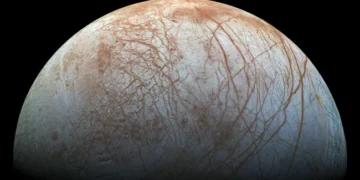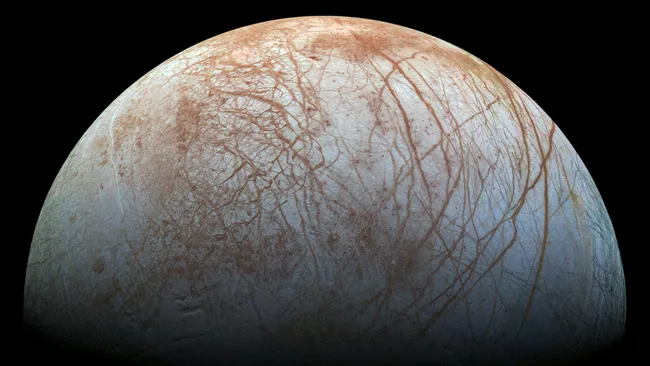Jupiter’s moon Callisto, long regarded as a frozen, crater-ridden celestial body, is now at the center of an exciting scientific breakthrough. New research strongly suggests that beneath its icy exterior lies a vast subsurface ocean, a discovery that could redefine our understanding of this distant moon and its potential for habitability.
A Paradigm Shift: From Cratered Wasteland to Ocean World
For a long time, Callisto was viewed as the least interesting of Jupiter’s four largest moons. Its heavily cratered surface, one of the most battered in the solar system, suggested a lack of internal activity. Unlike Europa, with its strikingly smooth and fractured ice shell—indicative of a subsurface ocean reshaping the surface—Callisto appeared frozen in time, leading many scientists to dismiss it as a dead moon.
However, that perception began to change in the 1990s, when NASA’s Galileo spacecraft flew past Callisto and gathered magnetic field data that hinted at something unexpected—a possible subsurface ocean beneath its icy crust. This was a startling discovery, but at the time, scientists weren’t entirely convinced. One major complication was Callisto’s dense ionosphere, an electrically conductive layer of its atmosphere, which could have been mimicking the electromagnetic signature of a liquid ocean.
Now, decades later, a new and more comprehensive study has revisited the Galileo data using modern computational tools and statistical models, and the results are clear: Callisto is very likely an ocean world.
Deciphering the Magnetic Mystery
One of the most fascinating aspects of Callisto’s potential ocean is how it was discovered—through magnetism rather than direct observation.
Planets and moons with subsurface oceans that contain salty water interact with external magnetic fields differently than solid, frozen objects. In the case of Callisto, scientists noticed that it reacted inductively to Jupiter’s powerful, ever-changing magnetic field, much like Europa and Ganymede. This response suggested the presence of an electrically conductive layer beneath the surface, which could be a global ocean of salty liquid water.
However, this interpretation was met with skepticism because Callisto has a highly ionized atmosphere. The presence of a strong ionosphere meant that it could have been producing a similar electromagnetic signature, leading to uncertainty about whether an ocean was truly there.
To resolve this, the latest study used all available magnetic data from Galileo’s eight close flybys of Callisto. By combining these measurements with advanced ionospheric modeling, the researchers were able to rule out the ionosphere as the sole source of the magnetic readings. The only explanation that fits all the data is the presence of a conductive subsurface ocean.
What Lies Beneath: Characteristics of Callisto’s Ocean
So, if Callisto does have an ocean, what does it look like?
The study suggests that the ocean lies beneath a thick ice shell, which could range anywhere from tens to hundreds of kilometers in thickness. This is significantly thicker than Europa’s ice shell, making it much harder to access with future spacecraft.
Beneath the ice, the ocean itself is estimated to be at least several tens of kilometers deep—deep enough to hold enormous amounts of water. For context, Earth’s deepest ocean trench, the Mariana Trench, is only about 11 kilometers deep.
This means that Callisto’s ocean could contain more liquid water than all of Earth’s oceans combined, making it one of the most intriguing places in the solar system.
Unlike Europa’s subsurface ocean, which is thought to be in direct contact with a rocky mantle, Callisto’s ocean likely sits atop a layer of high-pressure ice before reaching the rocky core. This difference is important because rock-water interactions can be a crucial factor for the emergence of life.
While Europa’s ocean floor may have hydrothermal vents, which on Earth provide energy for deep-sea ecosystems, Callisto’s ocean may be more isolated. However, even without direct rock interaction, there could still be biochemical processes occurring within the ocean, and some scientists argue that even isolated oceans could support life in unique ways.
What This Means for the Search for Life
The discovery of Callisto’s ocean has major implications for astrobiology—the study of life beyond Earth.
Liquid water is essential for life as we know it. With Callisto now appearing to host a vast, stable ocean, it becomes a new candidate for habitability in the outer solar system.
But what makes Callisto special compared to Europa and Ganymede?
- Radiation Shielding: One major advantage Callisto has over Europa is that it is farther from Jupiter and experiences significantly less radiation. Any potential life forms in Callisto’s ocean would not be subjected to the same extreme radiation levels that Europa endures.
- Stable Environment: Unlike Europa, which has active resurfacing and potential ice movement, Callisto’s ice shell is believed to be thicker and more stable, potentially offering long-term conditions favorable for life.
- Chemical Composition: If the ocean is salty, it means there are dissolved minerals present, which could create a chemical energy source for microbial life.
While Callisto may not be the top priority for astrobiologists—Europa remains the best candidate due to its thinner ice and possible seafloor interactions—the new findings expand the possibilities of where life could exist in the solar system.
Upcoming Missions: How Will We Confirm Callisto’s Ocean?
NASA and other space agencies have already planned upcoming missions that will investigate Jupiter’s moons, including Callisto.
- NASA’s Europa Clipper (Launching in 2025) – While primarily focused on Europa, this mission will conduct flybys of Callisto, gathering additional data on its magnetic field, ice thickness, and possible ocean.
- ESA’s JUICE (Jupiter Icy Moons Explorer, Arriving in 2031) – This European Space Agency mission will extensively study Callisto, Europa, and Ganymede, potentially providing direct confirmation of Callisto’s ocean.
- China’s Tianwen-4 Mission (In Planning) – China has expressed interest in observing Jupiter’s moons, which could add even more insights in the future.
These missions could revolutionize our understanding of Callisto and provide definitive proof of its subsurface ocean.
Conclusion: A New Chapter in Planetary Science
Callisto has gone from being considered a dull, cratered rock to a fascinating, dynamic ocean world that could harbor the ingredients for life.
With new research strongly supporting the presence of a salty subsurface ocean, Callisto now stands alongside Europa and Ganymede as one of Jupiter’s most intriguing moons.
Reference:
Corey J. Cochrane et al, Stronger Evidence of a Subsurface Ocean Within Callisto From a Multifrequency Investigation of Its Induced Magnetic Field, AGU Advances (2025). DOI: 10.1029/2024AV001237



















